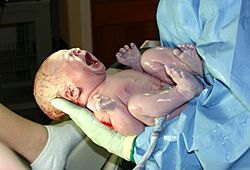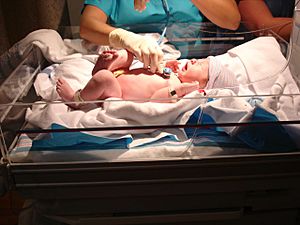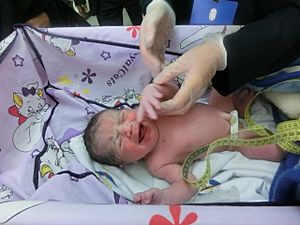Neonatology facts for kids
 |
|
| Occupation | |
|---|---|
| Names | Doctor, Medical Specialist |
|
Occupation type
|
Specialty |
|
Activity sectors
|
Pediatrics (medicine) |
| Description | |
|
Education required
|
|
|
Fields of
employment |
Hospitals, Clinics |

Neonatology is a special part of pediatrics. It focuses on the medical care of newborn babies. This is especially true for babies who are sick or born too early. Neonatologists usually work in neonatal intensive care units (NICUs) in hospitals.
The main patients for neonatologists are newborn infants. These babies might be sick or need special care. This can be because they were born too early (prematurity) or have a low birth weight. They also help babies with birth defects or infections.
Contents
Helping Newborns: A Look Back
For a long time, many babies did not survive after birth. But over the years, doctors learned more about newborns. They also developed new tools and special hospital units. This helped many more babies live and grow.
In the mid-1800s, doctors started to focus more on newborn care. By the early 1900s, pediatricians began to take a bigger role. The word "neonatology" was first used in 1960 by Dr. Alexander Schaffer.
Early Inventions for Babies
In 1835, a Russian doctor named Georg von Ruehl made a simple incubator. It was like two metal tubs with warm water between them. These "warming tubs" helped keep premature babies warm. In 1857, Jean-Louis-Paul Denuce also wrote about his own incubator design.
Later, in 1931, Dr. A Robert Bauer improved incubators. His designs could control humidity and give oxygen. These changes helped even more babies survive.
Big Steps in Baby Care
The 1950s brought many new ways to help newborns. Doctors learned how to use machines to help babies breathe. This meant even very small babies could survive.
In 1952, Dr. Virginia Apgar created the Apgar score. This is a quick check doctors do right after a baby is born. It helps them know if the baby needs extra help.
The first special unit for sick newborns, called a neonatal intensive care unit (NICU), opened in 1965. Before this, sick babies were in regular nurseries without special equipment.
In 1968, Dr. Jerold Lucey found that blue light could treat neonatal jaundice. This is a common condition where a baby's skin looks yellow. Now, light therapy is a main treatment for jaundice.
In the 1980s, a new medicine called pulmonary surfactant helped very premature babies. It also reduced lung problems in babies who needed breathing machines.
Becoming a Neonatologist
A neonatologist is a doctor who specializes in newborn care. In the United States, doctors first train to become a pediatrician. Then, they do extra training for about three years. This extra training focuses only on neonatology.
Most neonatologists are certified by special boards. This means they have passed exams to show they are experts. Many other countries have similar training programs.
Other Caregivers for Newborns
- Neonatal Nurse Practitioners (NNPs) are advanced nurses. They specialize in caring for newborns. They can help treat babies, plan their care, and even prescribe medicines.
- Neonatal nursing is a special type of nursing. These nurses focus on caring for newborns, especially those in the NICU.
What Neonatologists Do
Neonatologists focus on caring for newborns who need to stay in the NICU. They don't focus on just one body part. Instead, they care for the whole baby. They also might check on healthy newborns in the hospital.
Babies' bodies are still developing after birth. Their immune systems are not yet strong. Neonatologists help babies with many different health issues. Some common problems they treat include:
- Anemia of prematurity (low red blood cells in early babies)
- Apnea of prematurity (when premature babies stop breathing for short times)
- Bronchopulmonary dysplasia (a type of chronic lung disease)
- Congenital heart disease (heart problems present at birth)
- Intraventricular hemorrhage (bleeding in the brain)
- Meconium aspiration syndrome (when a baby breathes in their first stool before birth)
- Necrotizing enterocolitis (a serious gut problem)
- Neonatal jaundice (yellow skin from too much bilirubin)
- Neonatal respiratory distress syndrome (breathing problems in newborns)
- Neonatal sepsis (a serious infection)
- Retinopathy of prematurity (an eye condition in premature babies)
- Spina bifida (a birth defect of the spine)
Images for kids
See also
 In Spanish: Neonatología para niños
In Spanish: Neonatología para niños




